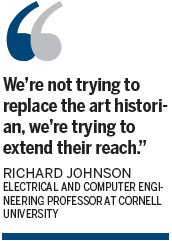Art detective finds hidden treasures behind canvases
High-tech approach can help prove if world-famous works are genuine
Richard Johnson can see right through masterpieces by Rembrandt and Van Gogh.
The Cornell University electrical and computer engineering professor is a digital art detective, able to unlock the mysteries of a work's age and authenticity by analyzing its underlying canvas or paper.
Using high-resolution X-ray images, the 64-year-old academic can determine if paintings came from the same bolt of hand-loomed canvas, each of which has a varying thread density pattern that can be as unique as a fingerprint.
Linking multiple pieces of canvas to the same bolt can shore up arguments for authenticity, and even put works in chronological order.
It's a valuable service to the world's top museums that comes through the unlikely cross-pollinating of traditional art history and contemporary computer science.
"By mixing the two, we've been able to do more than either group had been able to do separately studying the paintings," Johnson said in a room full of Dutch works at the New York university's Johnson Museum. "We're not trying to replace the art historian, we're trying to extend their reach."
Johnson is a tech whiz and an art lover - the rare person able to speak with authority about Rembrandt's brush strokes and adaptive feedback systems theory.

Although he didn't make his first visit to an art museum until he was a student on fellowship in Germany, the rooms full of Rembrandts left him thunderstruck.
Johnson melded the two worlds in 2007 with a stint as an adjunct research fellow at the Van Gogh Museum in Amsterdam. He began examining high-resolution X-ray images of the canvases used by the 19th-century master.
Eventually, Johnson and Don Johnson (no relation), a professor of electrical and computer engineering at Rice University in Houston, Texas, developed digital "weave density maps" of canvases that added computational power to what had been a painstaking process that required scholars to study small samples with magnifying glasses.
Louis van Tilborgh, senior researcher at the Van Gogh Museum, said, "It turns out that with the eye, you make mistakes."
Van Tilborgh sees the weave maps as an important tool for precisely dating and placing all of Vincent Van Gogh's paintings in order.
The technique has also provided evidence to date Diego Velazquez's Sebastian de Morra. A separate analysis of 24 Johannes Vermeer canvases supported the sometimes doubted attribution of one painting and provided fresh evidence to link two paintings at the National Gallery in London as complementary works.
(China Daily 11/20/2014 page10)














